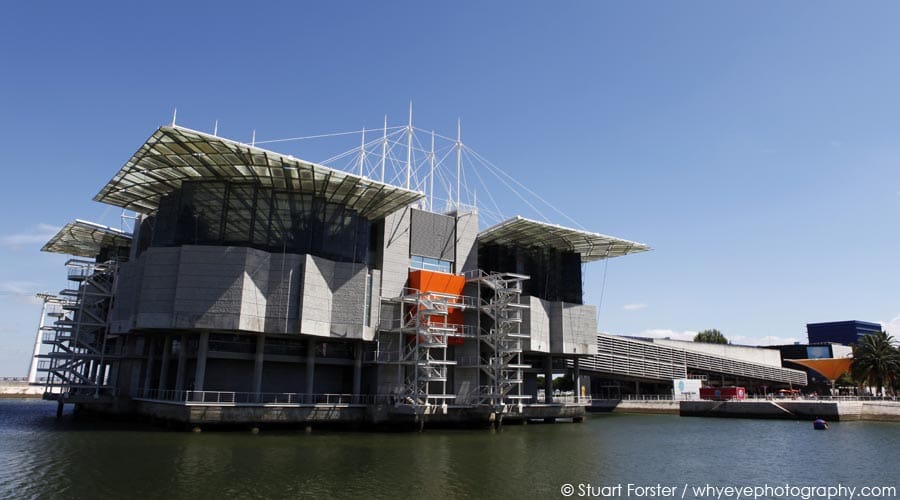Stuart Forster outlines what to expect when visiting Lisbon’s Oceanarium.
Lisbon’s Oceanarium, the Oceanário de Lisboa as it’s known locally, is an example of a tourist attraction that successfully grabs and holds the attention of adults as well as kids.
The popular aquarium is housed in a building designed by Peter Chermayeff, one of the legacies of the World Exposition hosted by Lisbon in 1998. The Oceanarium is surrounded by a pool of water and entered via a long ramp that leads up from the ticket office. It’s said that the building symbolises a ship in port, the ramp a gangplank; decide for yourself if the symbolism works.
A legacy of Expo ’98
These days the Expo ‘98 site is known as the Parque das Nações (Park of Nations) and continues to draw crowds more than two decades after its construction. More than a million people visit the Oceanarium each year. There’s also plenty to do nearby. Restaurants and bars, the Vasco da Gama Shopping Mall, cable car, casino and riverside views of the Vasco da Gama bridge ensure a trip here is worthwhile.
The main draw of the Oceanarium is a vast central tank, the home to an impressive array of marine species, including sharks, a manta ray and sunfish. It’s noteworthy for its sheer size. The tank holds five million litres of water and, due to the pressures exerted by that volume of water over two storeys, has windows that are up to 27cm thick.
It’s fascinating to watch the various species swim by and the rays showing their undersides as they glide along the glass. Few activities can be as relaxing, therapeutic almost, as sitting on the Oceanarium’s lower level and simply observing the creatures’ behaviour.
Marine life at Lisbon’s Oceanarium
Apart from the main tank, the building holds sections dedicated to the North Atlantic, Antarctic, Temperate Pacific and Tropical Indian marine environments. The North Atlantic section is the home to puffins and other seabirds, which can be seen diving into the cool water of the tank in the search for food. Magellan penguins totter around on the rocks of the notably cool Antarctic section, which has jutting sheaths of ice that visitors often touch to check the authenticity. Cute Pacific Otters draw “oohs” of sympathy from onlookers as they rub and preen their dense fur in the Temperate Pacific section.
The lower floor is the home to a number of smaller tanks housing an array of marine species, including giant spider crabs, sea dragons and octopuses. It’s here that you can start to appreciate the diversity of forms and colours of creatures living within the world’s oceans.
Environmental awareness and conservation
The descriptive legends within the Oceanarium are written in both Portuguese and English, providing snippets of information about the animals living in the tanks and raising awareness of environmental issues and threats. If you want detailed information audio guides are available.
Though visitors don’t always see it, the Oceanarium also has a serious side. Scientists here are involved in projects with conservational, environmental and scientific research purposes. Consequently, the message that people need to be environmentally aware and act responsibly in order to hinder the further depletion of ocean species is clearly conveyed.
If you like stats and logistics then a snapshot of the running of the Oceanarium will prove fascinating. Every month 20 tonnes of salt are used to create 360,000 litres of saltwater for the tanks, which provide homes to 500 different species of marine life. The animals living within the Oceanarium chomp through 550kg of food every week and there’s a thought-provoking film (Portuguese with English subtitles) documenting the challenges of thawing and serving it. Frozen food is prepared for the fish swimming in the tanks as it helps minimise the risk of pathogens being introduced to the water.
Lisbon’s most visited attraction
Adults with young families, prepare yourselves for the fact that you’ll be shepherded through the souvenir shop, which is packed with soft toys, on leaving the Oceanarium.
There’s always the option of taking a snap with Vasco, the Oceanarium’s scuba diving mascot, located next to the shop, to record your visit.
If you have the freedom to visit at any time of the year and want to get the most out of your visit then plan a visit outside of August, when most of Portugal’s citizens take their summer holidays. The aquarium is popular – it ranks as Portugal’s most visited tourist attraction – and becomes very busy during the holiday season.
Further information
See opening times and entry prices on the Oceanarium website.
Thinking of visiting Lisbon’s Oceanarium? You can reach the Oceanario de Lisboa by public transport. Trains and the Metro stop at the nearby Oriente station. A number of bus lines run to the Park of Nations, where parking spaces are plentiful.
The Visit Lisbon and Visit Portugal websites have more about attractions in the Portuguese capital. Here’s a post on things to do during a 48-hour visit to Lisbon.
Photos illustrating this post are by Why Eye Photography.
If you enjoyed this post why not sign up for the free Go Eat Do newsletter? It’s a hassle-free way of getting links to posts on a monthly basis.
‘Like’ the Go Eat Do Facebook page to see more photos and content.



